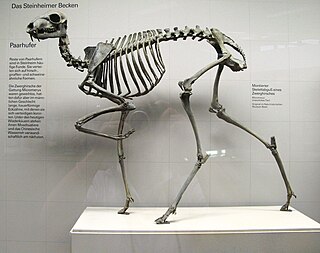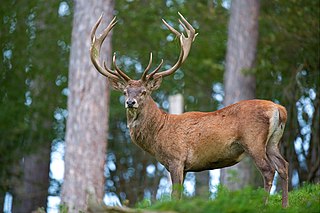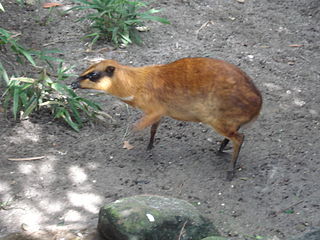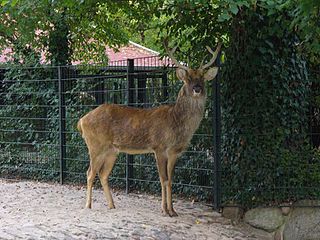
A lynx is any of the four extant species within the medium-sized wild cat genus Lynx. The name originated in Middle English via Latin from the Greek word lynx, derived from the Indo-European root *leuk-, in reference to the luminescence of its reflective eyes.

Weasels are mammals of the genus Mustela of the family Mustelidae. The genus Mustela includes the least weasels, polecats, stoats, ferrets, and European mink. Members of this genus are small, active predators, with long and slender bodies and short legs. The family Mustelidae, or mustelids, is often referred to as the "weasel family". In the UK, the term "weasel" usually refers to the smallest species, the least weasel (M. nivalis), the smallest carnivoran species.

A deer or true deer is a hoofed ruminant ungulate of the family Cervidae. Cervidae is divided into subfamilies Cervinae and Capreolinae. Male deer of almost all species, as well as female reindeer, grow and shed new antlers each year. These antlers are bony extensions of the skull and are often used for combat between males.

Artiodactyls are placental mammals belonging to the order Artiodactyla. Typically, they are ungulates which bear weight equally on two of their five toes. The other three toes are either present, absent, vestigial, or pointing posteriorly. By contrast, most perissodactyls bear weight on an odd number of the five toes. Another difference between the two orders is that many artiodactyls digest plant cellulose in one or more stomach chambers rather than in their intestine. Molecular biology, along with new fossil discoveries, has found that cetaceans fall within this taxonomic branch, being most closely related to hippopotamuses. Some modern taxonomists thus apply the name Cetartiodactyla to this group, while others opt to include cetaceans within the existing name of Artiodactyla. Some researchers use "even-toed ungulates" to exclude cetaceans and only include terrestrial artiodactyls, making the term paraphyletic in nature.

The roe deer, also known as the roe, western roe deer, or European roe, is a species of deer. The male of the species is sometimes referred to as a roebuck. The roe is a small deer, reddish and grey-brown, and well-adapted to cold environments. The species is widespread in Europe, from the Mediterranean to Scandinavia, from Scotland to the Caucasus, and east as far as northern Iran.

Moschidae is a family of pecoran even-toed ungulates, containing the musk deer (Moschus) and its extinct relatives. They are characterized by long 'saber teeth' instead of horns, antlers or ossicones, modest size and a lack of facial glands. While various Oligocene and Miocene pecorans were previously assigned to this family, recent studies find that most should be assigned to their own clades, although further research would need to confirm these traits. As a result, Micromeryx, Hispanomeryx, and Moschus are the only undisputed moschid members, making them known from at least 18 Ma. The group was abundant across Eurasia and North America during the Miocene, but afterwards declined to only the extant genus Moschus by the early Pleistocene.

Chevrotains, or mouse-deer, are diminutive, even-toed ungulates that make up the family Tragulidae, and are the only living members of the infraorder Tragulina. The 10 extant species are placed in three genera, but several species also are known only from fossils. The extant species are found in forests in South and Southeast Asia; a single species, the water chevrotain, is found in the rainforests of Central and West Africa. In November 2019, conservation scientists announced that they had photographed silver-backed chevrotains in a Vietnamese forest for the first time since the last confirmed sightings in 1990.

The European fallow deer, also known as the common fallow deer or simply fallow deer, is a species of deer native to Eurasia. It is historically native to Turkey and possibly the Italian Peninsula, Balkan Peninsula, and the island of Rhodes near Anatolia. Prehistorically native to and introduced into a larger portion of Europe, it has also been introduced to other regions in the world. It is one of two living species of fallow deer (Dama) alongside the Persian fallow deer.

Lama is a genus containing the South American camelids: the wild guanaco and vicuña and the domesticated llama, alpaca, and the extinct chilihueque. Before the Spanish conquest of the Americas, llamas, alpacas, and chilihueques were the only domesticated ungulates of the continent. They were kept not only for their value as beasts of burden, but also for their flesh, hides, and wool.

The red deer is one of the largest deer species. A male red deer is called a stag or hart, and a female is called a doe or hind. The red deer inhabits most of Europe, the Caucasus Mountains region, Anatolia, Iran, and parts of western Asia. It also inhabits the Atlas Mountains of Northern Africa; being the only living species of deer to inhabit Africa. Red deer have been introduced to other areas, including Australia, New Zealand, the United States, Canada, Peru, Uruguay, Chile and Argentina. In many parts of the world, the meat (venison) from red deer is used as a food source.

The water deer is a small deer species native to Korea and China. Its prominent tusks, similar to those of musk deer, have led to both subspecies being colloquially named vampire deer in English-speaking areas to which they have been imported. It was first described to the Western world by Robert Swinhoe in 1870.

The tufted deer is a small species of deer characterized by a prominent tuft of black hair on its forehead and fang-like canines for the males. It is a close relative of the muntjac, living somewhat further north over a wide area of central China and northeastern Myanmar. Suffering from overhunting and habitat loss, this deer is considered near-threatened. It is the only member of the genus Elaphodus.

Thorold's deer is a threatened species of deer found in the grassland, shrubland, and forest habitats, at high altitudes, of the eastern Tibetan Plateau, as well as some fragmented areas further north in central Western China. It is also known as the white-lipped deer for the white fur around its snout.

The Pampas deer is a species of deer that live in the grasslands of South America at low elevations. They are known as veado-campeiro in Portuguese and as venado or gama in Spanish. It is the only species in the genus Ozotoceros.

The Antilocapridae are a family of ruminant artiodactyls endemic to North America. Their closest extant relatives are the giraffids. Only one species, the pronghorn, is living today; all other members of the family are extinct. The living pronghorn is a small ruminant mammal resembling an antelope.

The white-bellied musk deer or Himalayan musk deer is a musk deer species occurring in the Himalayas of Nepal, Bhutan, India, Pakistan and China. It is listed as endangered on the IUCN Red List because of overexploitation resulting in a probable serious population decline.

The Philippine mouse-deer, also known as the Balabac chevrotain or pilandok, is a small, nocturnal ruminant, which is endemic to Balabac and nearby smaller islands southwest of Palawan in the Philippines. The genus Tragulus means 'little goat' and the Philippine mouse-deer has been named so due to the horizontal pupils of the eyes. This position of the pupil allows for an increase in peripheral depth perception. It has traditionally been considered a subspecies of the greater mouse-deer. In 2004, though, T. nigricans was separated from T. napu as its own species due to differences in skull morphology. Contrary to its common name, the Philippine mouse-deer does not belong to the true deer family (Cervidae), but is rather more closely connected to antelope and antelope-like bovids; it is a member of the chevrotain family, a grouping of some of the world's smallest hoofed mammals.

The greater mouse-deer, greater Malay chevrotain, or napu is a species of even-toed ungulate in the family Tragulidae found in Sumatra, Borneo, and smaller Malaysian and Indonesian islands, and in southern Myanmar, southern Thailand, and peninsular Malaysia. Its natural habitat is subtropical or tropical, moist, lowland forest.

Rucervus is a genus of deer from India, Nepal, Indochina, and the Chinese island of Hainan. The only extant representatives, the barasingha or swamp deer and Eld's deer, are threatened by habitat loss and hunting; another species, Schomburgk’s deer, went extinct in 1938. Deer species found within the genus Rucervus are characterized by a specific antler structure, where the basal ramification is often supplemented with an additional small prong, and the middle tine is never present. The crown tines are inserted on the posterior side of the beam and may be bifurcated or fused into a small palmation.

Fallow deer is the common name for species of deer in the genus Dama of subfamily Cervinae.



















